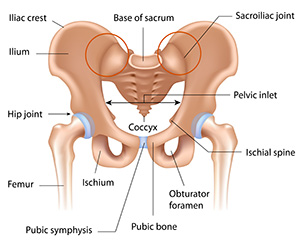-
Board-Certified
Fellowship-Trained
Physical Medicine
& Rehabilitation
Sacroiliac Pain and SI Fusion
What is Sacroiliac Pain?
At the bottom of your spine are two sacroiliac joints, one on either side by your two hip bones, attached to the sacrum, which is sometimes call the tailbone.
If you feel a pain in your low back when you stand up from a chair, it could be caused by your sacroiliac joint. There are two SI joints at the bottom of the spine. Standing up can trigger a pain which may be felt usually on one side of the low back. It’s estimated that up to one in four people with low back pain may have it linked to the SI joint.
An SI joint can be inflamed by falling down, or from repetitive motions like distance running. In other cases arthritis can cause problems with an SI joint.
This joint disorder may be called degenerative sacroiliitis. This can include cases where symptoms began during pregnancy and persisted six months after birth.
 Treatment options for a painful Sacroiliac Joint
Treatment options for a painful Sacroiliac Joint
South Carolina Spine Center emphasizes non-surgical treatment options in advance of spine surgery.
Spine therapy: Customized exercises may help in correcting posture and limps that may have developed by trying to walk painfree. Massage, ultrasound and stretching may provide some relief.
Injection therapy: Spinal injections of cortisone can reduce inflammation in the SI Joint, and can numb the problematic nerves in that area.
If spine surgery is needed for sacroiliac joint pain, South Carolina Spine Center has two fellowship-trained neurospine surgeons — the highest level of medical education possible. The surgical option to permanently relieve pain from a sacroiliac joint is called a SI Joint Fusion.
What is a Sacroiliac Joint Fusion (SI Fusion)?
Sacroiliac joint fusion is a minimally invasive surgical procedure performed with anesthesia and takes about an hour. An SI fusion is a surgery that involves special tools, techniques, implants and computer systems. The computerized navigation system helps the surgeon guide the instruments that prepare the bone and insert the implants.
The iFuse Implant System is a minimally invasive surgical option used by the surgeons at South Carolina Spine Center to minimize the disruption to surrounding tissue during the operation to help speed up your recovery and return to activity.
The entire procedure is performed through a small incision around the side of patient’s buttock. During the procedure, fluoroscopy provides the surgeon with live imaging and normally three implants will be inserted, depending on the patients individual body size. Your surgeon will decide when you can return home based on your post-surgical condition and degree of movement.
Overview on ("SI Fusion")
The sacroiliac joint (SI) iFuse Implant System is a new minimally invasive surgical option to relieve sacroiliac joint pain. The iFuse Implant System was designed as a minimally invasive surgical option for sacroiliac joint pain patients who are unresponsive to conventional non-surgical treatment options and therapy. Benefits can include smaller incision and less disruption to muscles and ligaments; less blood loss and the need for outside blood; less time in the operating room under anesthesia; and the implant eliminates the need for bone grafting or cadaver-sourced bone.
When is a SI Fusion performed?
The iFuse Implant System is intended for sacroiliac fusion for conditions including sacroiliac joint disruption and degenerative sacroiliitis.
Benefits
The iFuse Implant System is the only sacroiliac joint fusion system with multiple clinical studies demonstrating that treatment improved patient function, decreased pain, and better quality of life. The iFuse Implant System for sacroiliac joint pain has been performed on over 25,000 patients. South Carolina Spine Center spine surgeons use state of the art minimally invasive techniques and instrumentation to help patients recover in a shorter period of time and allow for a quicker return home.
Recovery
Following the iFuse Implant System surgery, your surgeon will arrange follow-up visits to assess your healing, incision site, and may take images of your surgical site for analysis. Your doctor will advise you when it is appropriate to resume your daily activities again and return to work.
SI iFuse Frequently Asked Questions
The iFuse Implant System is less invasive than traditional sacroiliac joint surgery. The iFuse Implant System is designed specifically to stabilize and fuse the sacroiliac joint and the implant is made from rigid titanium construction. The iFuse Implant System uses a much small incision size and no bone grafting is needed, as opposed to traditional sacroiliac joint fusion.
Physician Biographies
-
 Karl Boellert, MD
Karl Boellert, MD -
 Mathew Gowans, MD
Mathew Gowans, MD- Board-Certified
Physical Medicine
& Rehabilitation
- Board-Certified
-
 Michael P.B. Kilburn, MD
Michael P.B. Kilburn, MD-
Board-Certified
Fellowship-Trained
Spinal Neurosurgeon
-
Board-Certified
-
 Sumeer Lal, MD
Sumeer Lal, MD-
Board-Certified
Fellowship-Trained
Spinal Neurosurgeon
-
Board-Certified
-
 John Cole, MD
John Cole, MD-
Board-Certified
Fellowship-Trained
Spinal Neurosurgeon
-
Board-Certified
Back to Life Journal

Home Remedy Book

![]() Website Design & Educational Content © Copyright 2023 Prizm Development, Inc.
Developing Centers of Excellence for Better Healthcare.
Website Design & Educational Content © Copyright 2023 Prizm Development, Inc.
Developing Centers of Excellence for Better Healthcare.
Prizm is the most experienced developer of spine and orthopedic centers in the U.S. with content-rich educational web sites for physicians.
